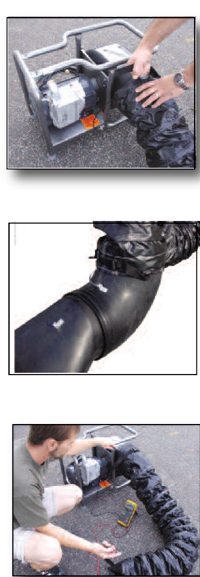The Conductive Saddle Vent® System
|
|
|---|---|
| The original Saddle Vent® was constructed of standard polyethylene which carries the potential of static electricity build-up on its surface. Static electricity is a source of ignition for fire and explosions. Air Systems developed an improved Saddle Vent® to safely remove potential static electricity charges from the ventilation system. The use of conductive polyethylene to construct the Saddle Vent® and conductive ventilation duct now provides the safest possible confined space ventilation procedure available.. The fully Conductive Saddle Vent® removes static electricity from the entire ventilation system when installed properly. Saddle Vent® is a Registered Trademark of Air Systems International, Inc.. |
|
| U.S. Patente: #6,843,274 - #7,467,645 - #7,992,593 B2 Kanadische Patente: #2,561,299 - #2,436,809 China Patente: CN1813137B Europäische Patent: #1491695 Australische Patente 2004 202394 Andere U.S. und International Patents Pending |
|
| The Conductive Saddle Vent®System Set Up Procedure: Step 1) Select an electric explosion-proof or pneumatic blower with aninstalled metal grounding lug. Step 2) Read and follow recommended work procedures found in ANSI/API2015 and 2016 prior to entering a tank or confined space. Step 3) Use only conductive ducting supplied with a continuous metal helix and a static ground wire connected to the helix. The ground wire isconnected to the metal ground lug on the blower. (See Pic. 1). Step 4) Attach the conductive elbow to the top of the black Conductive Saddle Vent®, (see Pic. 2), and attach the ground wire from the duct to the elbow. If no elbow is used, an alternate ground lug is provided on the top of the Saddle Vent®. Step 5) Attach conductive duct to the base of the Saddle Vent® and attach the ground wire to the Saddle Vent®. Step 6) Test the ventilation set-up for conductivity prior to starting ventilation. Use a volt/ohm meter set to read ohms in “thousands”. Attach a lead from the meter to the farthest end of the duct’s grounding wire and the other lead touching the ground lug on the blower. A readingless than 500K ohms will assure a good ground is achieved to allow anystatic charges to flow toward the grounded source (See Pic. 3). Pneumatic blowers should have a ground wire run from the blower to a grounded source. Step 7) The ventilation system is now ready for use. Place the duct and Saddle Vent® system in the manhole and secure with the universal mount. Follow the “Typical Saddle Vent® set-up procedure found in your blower’s instruction manual. |
 |
